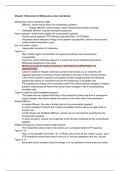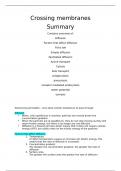Ficks law Study guides, Class notes & Summaries
Looking for the best study guides, study notes and summaries about Ficks law? On this page you'll find 22 study documents about Ficks law.
Page 2 out of 22 results
Sort by
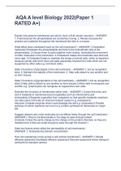
-
AQA A level Biology 2022(Paper 1 RATED A+)
- Exam (elaborations) • 13 pages • 2023
- Available in package deal
-
- $10.99
- + learn more
Explain why plasma membranes are said to have a fluid mosaic structure. - ANSWER 1. Fluid because the phospholipids are constantly moving. 2. Mosaic because the proteins are scattered throughout the membrane-like tiles in a mosaic. What effect does cholesterol have on the cell membrane? - ANSWER 1.Cholesterol molecules fit between the phospholipids and bind to the hydrophobic tails of the phospholipids. 2.Causes them to pack together more closely, restricting the movement of other molecules i...
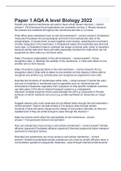
-
AQA A level Biology 2022/2023 AQA with verified questions and answers
- Exam (elaborations) • 13 pages • 2023
- Available in package deal
-
- $12.99
- + learn more
Explain why plasma membranes are said to have a fluid mosaic structure. 1. Fluid because the phospholipids are constantly moving. 2. Mosaic because the proteins are scattered throughout the membrane-like tiles in a mosaic. What effect does cholesterol have on the cell membrane? 1.Cholesterol molecules fit between the phospholipids and bind to the hydrophobic tails of the phospholipids. 2.Causes them to pack together more closely, restricting the movement of other molecules in the membra...
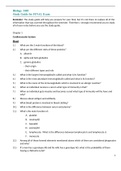
-
Biology 2402 Study Guide for FINAL Exam
- Other • 10 pages • 2022
-
- $12.49
- + learn more
Cardiovascular System Blood 1.) What are the 3 main functions of the blood? 2.) What are the different roles of these proteins? A. albumin B. alpha and beta globulins C. gamma globulins ‐ their origin ‐ their different types and role 3.) What is the largest immunoglobulin called and what is its function? 4.) What is the most abundant immunoglobulin called and what is its function? 5.) What is the name of the immunoglobulin which is involved in an allergic reaction? 6.) When an ...
Human Phys Chapter 4

-
Understanding Gas Exchange and Circulatory Systems: Lecture 21 Overview
- Class notes • 3 pages • 2024
-
- $8.49
- + learn more
This document encapsulates the core concepts discussed in Lecture 21, focusing on organisms' gas exchange and circulatory systems. It elaborates on Fick’s Law and the Hagen-Poiseuille Equation, explaining how physical constraints influence the evolution of gas exchange organs and circulatory systems. Furthermore, it delves into the mathematical formulations of gas flux and flow rate, emphasizing the crucial role of concentration gradients and pressure differentials in gas exchange. The docume...
Summary of what you need to know for a level biology ocr a crossing membranes including topics such as diffusion (facilitated, endo and exocytosis and simple) and osmosis.
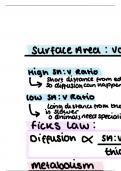
-
AS Biology-Topic 3- Exchange-systems(insects/fish/plants/humans)-summary
- Summary • 1 pages • 2024
-
- $8.04
- + learn more
This summary page is hand written on an iPad.It is a colourful and detailed and includes diagrams and drawings to help you visualise and learn key concepts as well clearly layer out adaptations for each exchange systems. Also includes keywords and concepts of rick’s law and surface are to volume ratio!These really helped me achieve my As/A* in mocks .

-
A. Stimulus, effector, efferent pathway, integrating center, afferent
- Exam (elaborations) • 1 pages • 2023
-
- $7.47
- + learn more
A. Stimulus, effector, efferent pathway, integrating center, afferent pathway, receptor. B. Stimulus, receptor, efferent pathway, integrating center, afferent pathway, effector. C. Stimulus, receptor, afferent pathway, integrating center, efferent pathway, effector. D. Stimulus, effector, afferent pathway, integrating center, efferent pathway, receptor. E. Effector, efferent pathway, integrating center, afferent pathway, receptor, stimulus. 11. Which one of the following is the correct sequ...

-
A. Stimulus, effector, efferent pathway, integrating center, afferent
- Exam (elaborations) • 1 pages • 2023
-
- $7.47
- + learn more
A. Stimulus, effector, efferent pathway, integrating center, afferent pathway, receptor. B. Stimulus, receptor, efferent pathway, integrating center, afferent pathway, effector. C. Stimulus, receptor, afferent pathway, integrating center, efferent pathway, effector. D. Stimulus, effector, afferent pathway, integrating center, efferent pathway, receptor. E. Effector, efferent pathway, integrating center, afferent pathway, receptor, stimulus. 11. Which one of the following is the correct sequ...
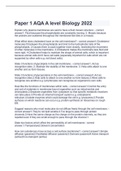
-
Paper 1 AQA A level Biology 2023 with complete solution
- Exam (elaborations) • 13 pages • 2023
-
- $10.99
- + learn more
Explain why plasma membranes are said to have a fluid mosaic structure. 1. Fluid because the phospholipids are constantly moving. 2. Mosaic because the proteins are scattered throughout the membrane-like tiles in a mosaic. What effect does cholesterol have on the cell membrane? 1.Cholesterol molecules fit between the phospholipids and bind to the hydrophobic tails of the phospholipids. 2.Causes them to pack together more closely, restricting the movement of other molecules in the membra...

Do you wonder why so many students wear nice clothes, have money to spare and enjoy tons of free time? Well, they sell on Stuvia! Imagine your study notes being downloaded a dozen times for $15 each. Every. Single. Day. Discover all about earning on Stuvia

